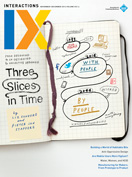Authors:
Gitte Lindgaard
Calls for novel user experience (UX) evaluation methods have been echoing through the HCI literature for several years. Although the traditional notions of effectiveness, efficiency, and satisfaction may not adequately capture all types of new interactive experiences, novel approaches would not necessarily render existing evaluation methods irrelevant. As Tom Stewart so aptly says, "Being pretty and engaging is not enough" [1]. Despite the proven longevity of traditional usability evaluation methods, the HCI literature still points to confusion about how UX, including usability, is and should be tested. One reason for this confusion is the undeniable distance between HCI research…
You must be a member of SIGCHI, a subscriber to ACM's Digital Library, or an interactions subscriber to read the full text of this article.
GET ACCESS
Join ACM SIGCHIIn addition to all of the professional benefits of being a SIGCHI member, members get full access to interactions online content and receive the print version of the magazine bimonthly.
Subscribe to the ACM Digital Library
Get access to all interactions content online and the entire archive of ACM publications dating back to 1954. (Please check with your institution to see if it already has a subscription.)
Subscribe to interactions
Get full access to interactions online content and receive the print version of the magazine bimonthly.






